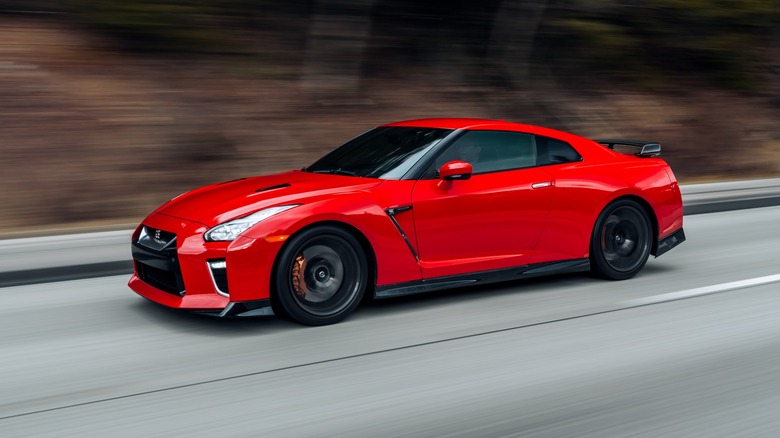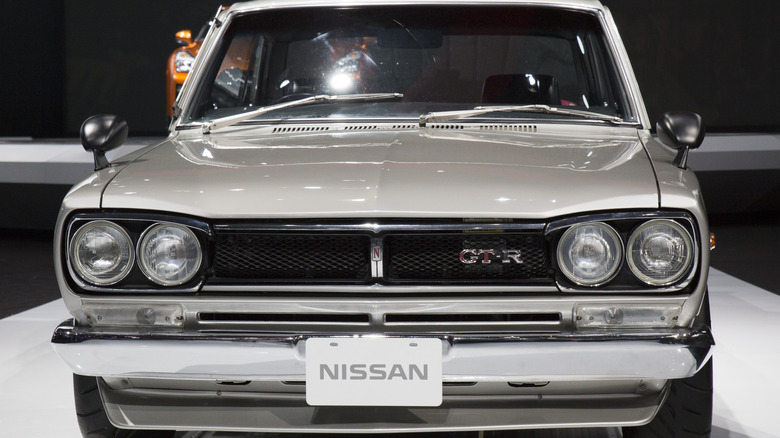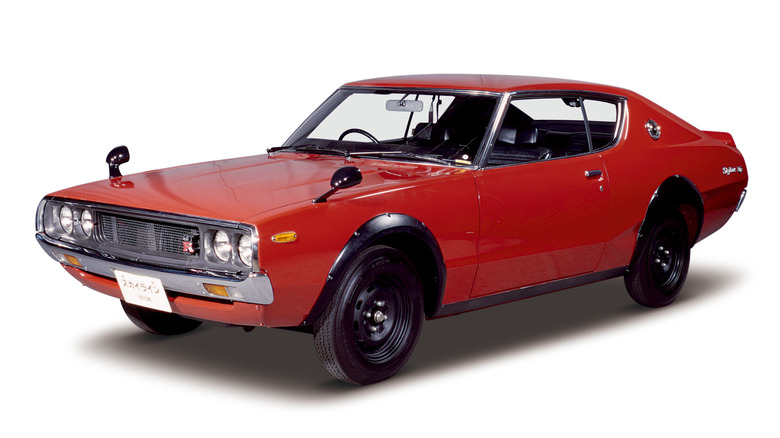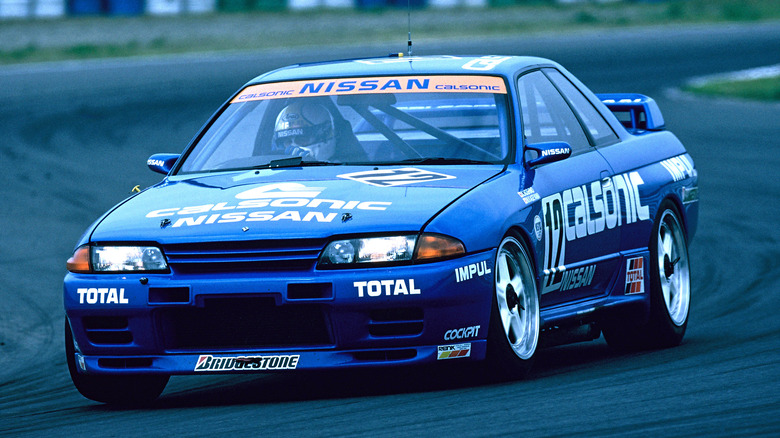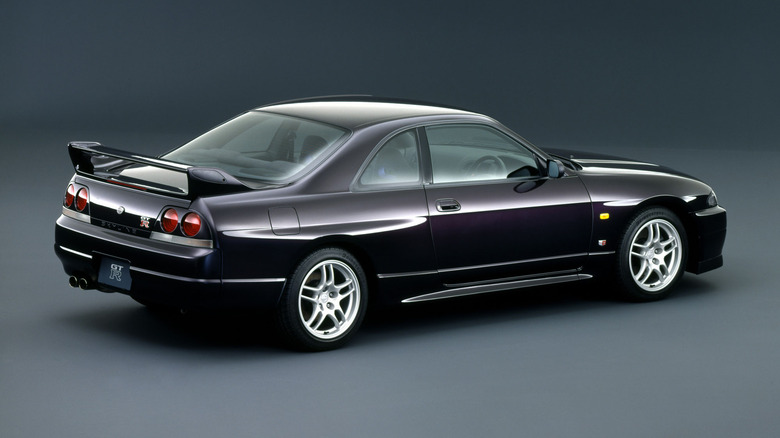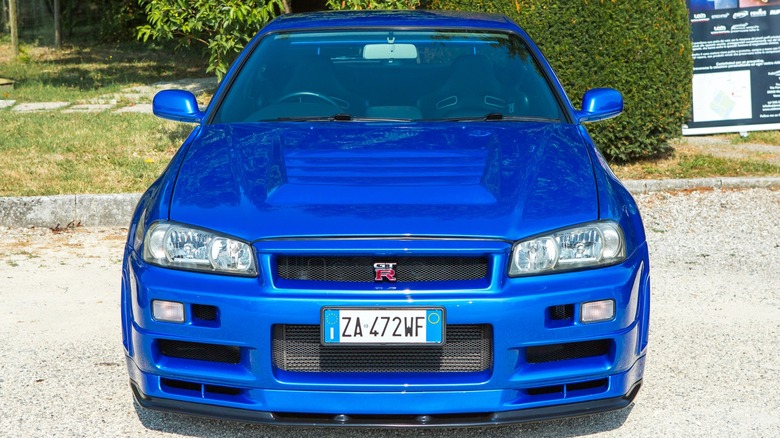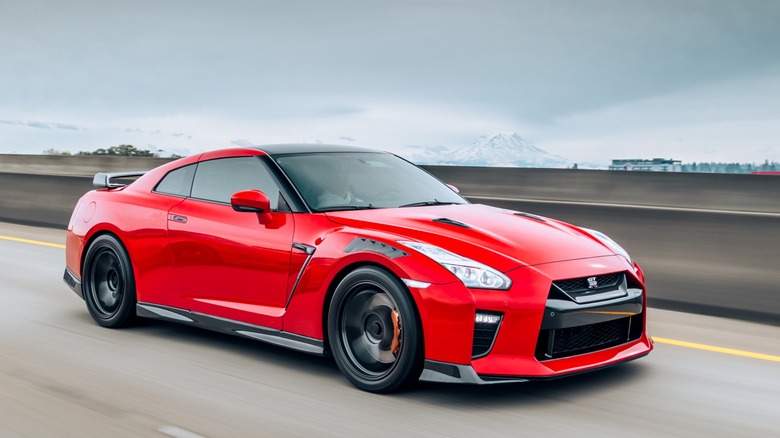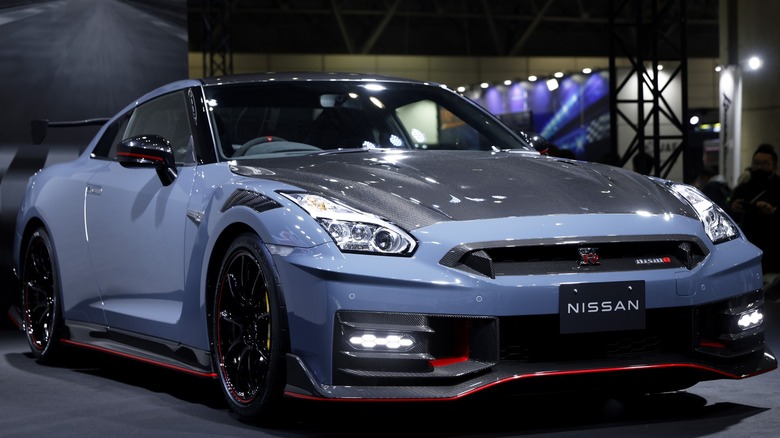A Look At The Evolution Of The Nissan GT-R
The Nissan GT-R is a historic name that spans a much broader timeline than many automotive enthusiasts may know. Sure, you're undoubtedly aware of the supercar-killing current-generation Nissan GT-R. It's a staple of every car meet, drag strip, road course, and almost every other discipline of car culture. However, the heritage of the name roots much deeper than that. You're likely familiar with the lineup of Nissan Skyline GT-R models, too. Still, though, the roots of the GT-R namesake run even deeper than the legendary Skyline models of the late 1980s through early 2000s.
In fact, the first iteration of the GT-R namesake roots all the way back to the late 1960s. Though there was quite a gap between the first GT-R and the re-introduction of the name, the heritage still spans a nearly 60-year timeline. Here's a look at the history of the Nissan GT-R through all of its evolutions and variations.
Hakosuka: The first Nissan GT-R
Incidentally, the GT-R pre-dates Nissan. The first GT-R was indeed a Skyline model. However, it was before the Skyline was a Nissan product. In 1964, Japanese automaker Prince stretched their family sedan, the Skyline, by eight inches and put a hopped-up 2.0-liter engine under the hood to enter it in the 1964 Japanese Grand Prix. Just five years later, Prince released its first high-performance production model of that very model. The Prince Skyline GT-R was born.
According to Hagerty, the coupe variant of the Prince Skyline GT-R came to market in 1971. Its success in the world of racing, with 49 consecutive racing wins, made the car quite appealing. The road-going version has a 2.0-liter dual-overhead-camshaft inline six-cylinder that makes an unforgettable scream as it makes its way through the rev range.
These first-born GT-R models are known as "Hakosuka," a combination of the Japanese words for "box" and Suka, a shorthand of the word sukarain, a type of Japanese mountain road. Heritage doesn't come cheap. According to Hagerty, you'll need around $128,000 for a four-door in good condition or $210,000 for a coupe.
C110 Nissan Skyline GT-R
The next evolution of the GT-R lineup came with the birth of the C110 Nissan Skyline. Technically, this was the first Skyline model to bear the Nissan namesake after the company's merger with Prince. So, on that technicality, this is the first Nissan Skyline GT-R.
Like the Hakosuka, the C110 Skyline GT-R used a 2.0-liter inline six-cylinder engine, according to FastestLaps. With 158 horsepower and 133 lb-ft of torque, it retained the high-performance spirit of the original. Its classic Japanese styling draws on American influence and has the legendary '70s Japanese fender-mounted mirrors. It's rear-wheel-drive and truly stunning to look at.
Hagerty values these beauties at $364,000 in good condition, which is heartbreaking from the perspective of normal folks. This is likely due to the fact that the 1973 model year was the only year a GT-R variant was available. So, they're quite rare. What's even more heartbreaking, though, is that this would be the last time a Nissan would keep the legendary GT-R namesake alive for over 15 years. The wait, though, was certainly worth it.
Godzilla is Born: The R32 Nissan Skyline GT-R
Welcome to the modern era. Though the original GT-R models from the '70s are undoubtedly the foundation of the performance cars we now know and love, the GT-R as we know it was truly born in 1989 with the introduction of the R32 Nissan Skyline GT-R.
It was truly a groundbreaking development from Nissan. With a "276 horsepower" twin-turbocharged 2.6-liter inline six-cylinder engine feeding power to a manual transmission that distributes said power across all four wheels, it was truly a force to be reckoned with.
If you've ever heard the nickname "Godzilla" associated with a GT-R, this car is why. Specifically, the racing version, which won every single Japanese Touring Car Championship race it started in for four seasons straight. An uninterrupted winning streak of 29 races truly pays homage to the birth of the GT-R namesake and reminds the world that Nissan could throw down on the circuit if they chose to. Its dominance in racing as an unstoppable Japanese monster gained it the nickname Godzilla among competitors.
The R32 GT-R is such a staple in the tuner world that, despite never being sold in the United States from new, it's one of the most regularly modified and cult-loved JDM cars in the American tuner scene.
The underloved R33 Skyline GT-R
The 1995 model year brought the next generation of the GT-R: the R33 Nissan Skyline GT-R. For whatever reason, this car is a bit underloved in the tuner world. From a psychological standpoint, it sort of makes sense to leave the "middle child" behind. However, stereotypes of the R33 GT-R being a "boat" due to its weight or less performance-oriented specs than its predecessor and successor are completely untrue.
Like the R32, the R33 GT-R uses the RB26DETT twin-turbocharged inline six-cylinder engine with "276 horsepower." Keen-eyed readers may have noted that this is the second time we've put that power level in quotation marks. In the late 1980s, Japanese automakers entered a "gentlemen's agreement" to limit performance car power output to 276 horsepower for the general safety of the consumers. Incidentally, many cars with "276 horsepower" that wind up on dynos in stock format have more power than that. Weird.
The R33's improvements over the R32 are very real and very underappreciated. The chassis is much stiffer than the R32's, and its weight distribution is far superior. Most importantly, the R33's updated all-wheel-drive system provided optimized traction control known as "ATTESA E-TS PRO," giving it superior handling characteristics and power delivery.
In addition, the R33 generation also offers one of the most valuable and rare GT-R models ever built. The 400R is a 400 horsepower monster worth well over $1 million, according to Hagerty.
R34 Nissan Skyline GT-R
Arguably, the most recognizable and enthusiast-loved GT-R model throughout the entire lineage is the R34 Nissan Skyline GT-R. Partially because everyone wants what they can't have, and given that none of these models were ever sold in the U.S., the R34 is the last Skyline GT-R and has only recently started to become legal for U.S. import. However, another major contributing factor to the R34's reign as king is undoubtedly its role as a hero car in the "Fast and the Furious" movie franchise.
The R34's styling is iconic. Its massive rear wing and signature huge round tail lights are instantly recognizable. More modern amenities in the R34 include an advanced display unit in the center of the dash that showcases live data like boost, g-forces, exhaust temp, intake temp, oil pressure, and more.
It also features a shorter wheelbase than the R33 with more streamlined aerodynamics and, of course, the signature RB26DETT twin-turbo inline-six with, you guessed it, 276 horsepower.
Though some R34 Skyline GT-R models are now legal for import to the U.S. because they're over 25 years old, a couple of variants have been legal for import via the "Show and Display" exemption. The R34 Skyline GT-R M-Spec Nur, GT-R V-Spec N1, and V-Spec Early Model Limited Edition are all deemed special enough to import so long as they don't get driven more than 2,500 miles per year.
R35 Nissan GT-R
After a hiatus from the end of the R34's production in 2002, Nissan revived the GT-R namesake again in 2009. Though the chassis code is indeed R35, the R35 GT-R is not a Skyline. The Skyline namesake did live on, too, but those models are JDM sedans and coupes that we got stateside as the Inifiniti G35, G37, and Q50 models.
With the gentlemen's agreement out of the way, the 2009 GT-R came out swinging with a fearsome 480 horsepower twin-turbocharged V6 engine that screams with the sound of an angry trombone as it accelerates through the rev range at an almost unbelievable rate. It was met with unadulterated admiration from critics, and its acceleration and handling characteristics put it on par with the likes of McLaren, Porsche, and Ferrari. It even had a faster 0-60 time than the 2009 Lamborghini Murcielago roadster. Autotrader reports that its original MSRP was just $69,850, so it's easy to see why it instantly became a hit.
It wasn't all sunshine and rainbows, though. Early GT-R owners began destroying transmissions by using the integrated launch control. The worst part, though, was the owners were told that using the launch control voided the warranty, according to Jalopnik. Eventually, a class-action lawsuit against Nissan for the transmissions led to the auto giant settling with owners.
Progression of the R35 GT-R
Though the GT-R is still around, it's not the affordable supercar killer it once was. Since its debut for the 2009 model year, styling hasn't changed much. Power output has gone up, but, unfortunately, so have prices.
The first major leap came in 2012 when power increased to 530 horsepower and 448 lb-ft of torque. Its 0-60 dropped below three seconds and came with slotted and drilled two-piece rotors. The starting price jumped to $89,950, with options and trims taking pricing to six figures.
A year later, power went up to 544 horsepower, pricing eclipsed $100,000 on the low end, and Nissan introduced a limited Track Edition model limited to 150 units. This birthed Nissan's tradition of selling special edition models to keep the GT-R afloat. 2015 introduced the $149,900 NISMO model with a 2.7-second sprint to 60 MPH and 600 horsepower on tap.
In 2017, Nissan gave the GT-R a facelift, though the styling remains pretty similar. Nissan only sold 700 GT-Rs in 2016 and under 600 in 2017. Now, Nissan only moves around 300 per year. Modern GT-Rs have 565 horsepower and a starting price of $113,540. The NISMO variant has 600 horsepower and costs an eye-watering $210,740. Overall, it's starting to look like the beginning of the end for the GT-R. Maybe, though, Nissan will come out swinging with a replacement in the future.
